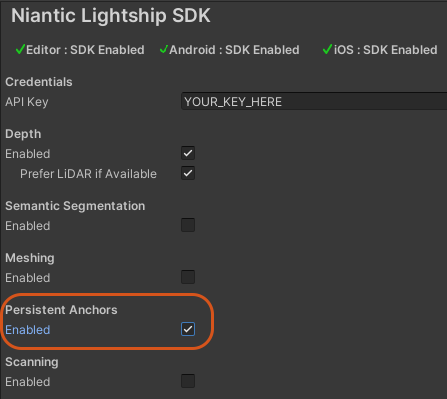How to Place Content in Real-World Locations Using Location AR
This how-to covers:
- Importing a real-world location from the Geospatial Browser (GSB) into Unity;
- Placing content in a real-world location;
- Testing placed content, either using a mockup or on location.
Prerequisites
You will need a Unity project with ARDK installed and a set-up basic AR scene. For more information, see Installing ARDK 3 and Setting up an AR Scene.
Adding a Real-World Location to Unity
To add an AR location to Unity:
- Add an AR Location Manager component to the
XROrigin:- Select the
XROriginin the Hierarchy, then, in the Inspector window, click Add Component and search for ARLocationManager. - In the ARLocationManager Component, click Add AR Location to create a new
ARLocation.
- Select the
- Turn on Persistent Anchors in Lightship Settings:
- Click the Lightship top menu, then select Settings.
- In the Inspector window, check the Enabled box next to Persistent Anchors.

Importing a Location from the Geospatial Browser
To import a location:
- Go to the Geospatial Browser and find the location you want to build content for. The data will download as a .zip file; do not unzip it. For more information on downloading location data, see Downloading Meshes.
- Drag and drop the downloaded zip file into the Assets directory in the Project window. Once the import process completes, it will create two assets, a Mesh and a Manifest.
- In the Hierarchy, select the
ARLocationto show its Component in the Inspector. Drag and drop the Manifest from the Assets directory to the AR Location Manifest field in the Component.
Building Real-World AR Content
When building your AR content, remember the following:
- Build your AR content as a child of the
ARLocation. For example, to add a Cube to a location:- In the Hierarchy, right-click the
ARLocation, then mouse over 3D Object and select Cube. - In the Inspector, set the cube's Scale to
0.5and its position to0,0,2.
- In the Hierarchy, right-click the
- Make sure to enable auto-tracking:
- In the Hierarchy, select the XROrigin, then, in the Inspector window, check the Auto-Track box in the ARLocationManager Component.
Testing Real-World AR Content
The simplest way to test real-world AR content is by building your Unity app to a device and physically visiting the location to test it out. Because this is not always possible, Lightship also provides Mock Mode, giving developers the ability to create a mock localization of the scene that allows GameObjects to run through their Behaviors.
To enter Mock Mode and test AR content:
- If you have enabled Playback, disable it.
- Enter Play Mode. Lightship will add a Mock Camera asset to your scene that allows movement with the WASD keys and zooming with the scroll wheel. This will also create a mock localization that allows GameObjects to run through their Behaviours.